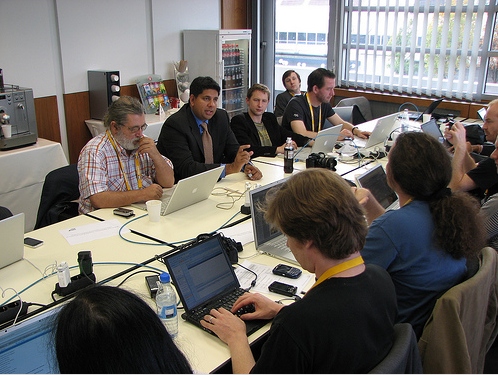Might the SAP Mentors inherit the earth?


Co-innovation and joint engineering only make most sense in the context of open intellectual property, and SAP still has some way to go in this regard. Not invented here is alive and well at SAP, although it is under increasing pressure.
The Mentors found their voice earlier in the year when an issue emerged that caused them to rise up as one and deliver a clearly articulated message to SAP executives: "You've made a dumb decision that's going to stop us doing our experimental development work. Sort it out." To the company's credit, it resolved the matter in 24 hours. But it showed for the first time, just how important and powerful this group can be.
At TechEd, Zia heard first hand about the importance of opennesss from James Governor and others in the Mentor/blogger group. It was noticeable that he didn't argue but listened intently. Hervé Couturier, the man charged with managing NetWeaver development also listened as the Mentors made the case for openness and open source. Hervé's BusinessObjects background positions him perfectly for understanding what's required. "It shouldn't be a case of 'why should we?' but one of 'why can't we?' " he said. Refreshing.
More intriguing from my point of view was that he candidly acknowledged the fact SAP is at risk of seeing its innovators shrug and pick up JBoss for free rather than go through the grueling IP forced march that SAP legal imposes on anyone developing for its NetWeaver platform. It struck me as extraordinary that SAP executives are apparently unaware that it is far easier to deal with Oracle and Microsoft than their own company.
I suspect a good part of that rests with a paranoia around lawsuits and a claimed lack of support for open source among its customers. It's a reasonable argument when contextualized to the TomorrowNow case but has almost no bearing on the reality of day to day business. If it did then by its own standards, SAP would never have bought BusinessObjects. That is because as Hervé acknowledged, BusinessObjects was way too loose with its use of open source. Neither would SAP deploy a stack of software tools that have been invented in recent years which bear all kinds of open source licensing gremlins. But it does and it has. Where do the Mentors fit in all this?
This year, they've shown that community based development can yield genuinely useful results that have commercial value. As far as I know, that's something of a first for SAP. But - it was done by bending and twisting every 'rule' in the book while maintaining a level of transparency that SAP has never seen before. Licensing issues have dominated that development and as I pointed out, it's an un-necessary, time consuming and energy sapping distraction at a time when developers want to concentrate on building great applications. Community managers can shield teams from much of the grunt but successful community teams require consensus and there is only so far one can go before the issues have to be addressed. Who needs it? Back to James Governor:
So why insist that ABAP or any other programming language is the only language in which to build software? Not invented here is a luxury that few if any software companies can afford, which is why its good to see investing in dynamic scripting languages such as PHP and Ruby On Rails, cajoled by change agents such as the inestimable Craig Cmehil.
The core is mySAP, surrounding that is NetWeaver, the information glue is Business Objects, fast muscle twitch fibre might come from another third party such as ESME.
To ignore software built elsewhere is to be economically hamstrung.
As I gauge Herve's responses, I detect the first tentative steps are being taken to open up SAP to a much broader community of potential developers. As the company that owns so much of enterprise by volume of code, the company has nothing to lose and everything to gain from encouraging more developers to jump into its ecosystem. Heck - it's got the EcoHub waiting there for smart folks to drop new products into the pool. While I was there, a rep from their Collaboration Workspace team was keen to tell our community development team about the advantages of operating within that environment. More encouraging still was an email Michael Bechauf, VP NetWeaver standards sent to the Mentors:
We had great meetings and good dialogue, but I was particularly proud of the amazing meeting with Hervé Couturier and Sal Visca yesterday. This meeting was a testimonial to the value the Mentors add to, and I want to thank you for your support. You were great!
If SAP truly believes that then the Mentors have communicated well to gracious hosts. It is now up to SAP to deliver on developer needs.
One final note. On the evening of the Steve Winwood concert, Zia asked me if I'd enjoyed TechEd. It was a terrific event for the energy of those in attendance and the willingness of senior execs to engage in robust and meaningful discussion. My response was caveated: "You've just got a couple of simple decisions to take." He smiled.
Disclosure: I have an interest in ESME.
Photos courtesy of David Terrar and Marilyn Pratt.
Image from Simon Wardley's presentation.